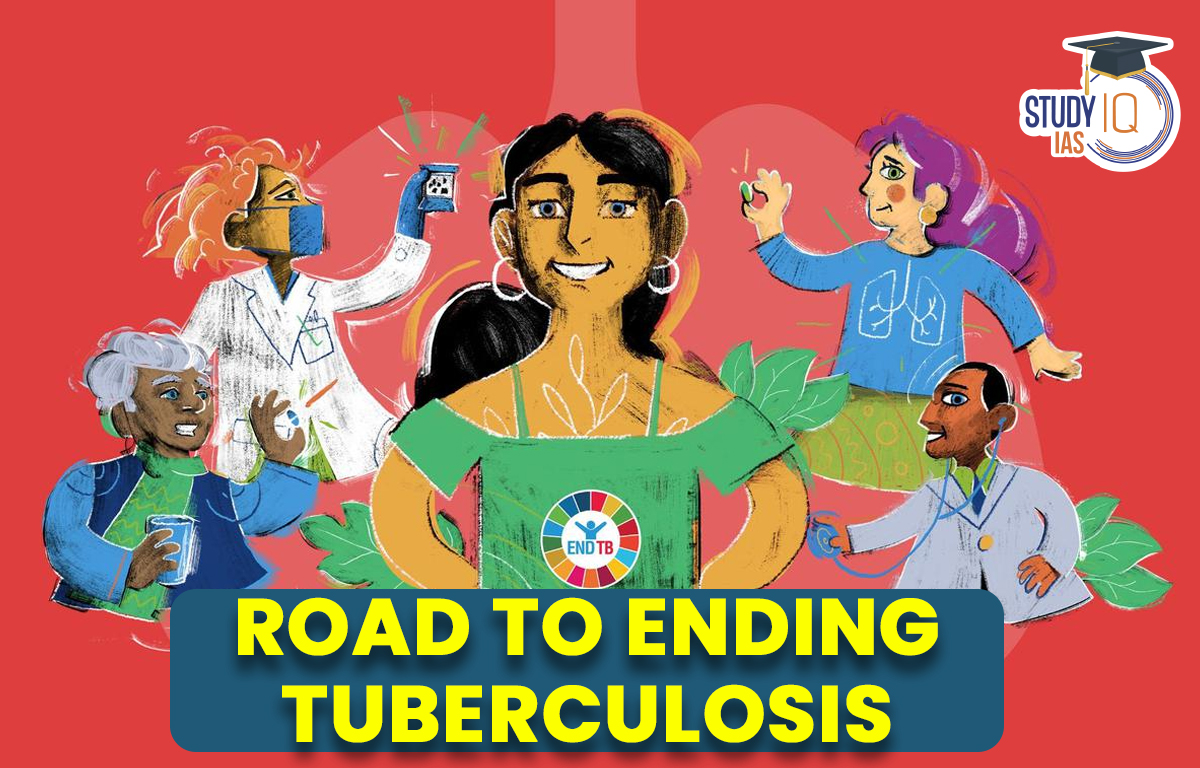Table of Contents
Context: There has been a rise in cases of tuberculosis (TB) in Maharashtra after the outbreak of Covid-19.
What is Tuberculosis (TB)?
- Tuberculosis (TB) is a bacterial infection spread through inhaling tiny droplets from the coughs or sneezes of an infected person.
- TB is caused by a bacterium called Mycobacterium tuberculosis, belonging to the Mycobacteriaceae family.
- Worldwide, TB is the 13th leading cause of death and the second leading infectious killer after COVID-19 (above HIV/AIDS).
- Transmission: TB spreads from person to person through the air. When people with lung TB cough, sneeze or spit, they propel the TB germs into the air.
- In humans, TB most commonly affects the lungs (pulmonary TB), but it can also affect other organs (extra-pulmonary TB).
- Cure: TB is a treatable and curable disease.
- Vaccine: Currently, Bacille Calmette-Guérin (BCG) is the only licensed vaccine available for the prevention of TB.
- BCG works well in some geographic locations and not so well in others.
- Generally, the farther a country is from the equator, the higher is the efficacy.
- It has a high efficacy in the UK, Norway, Sweden and Denmark; and little or no efficacy in countries on or near the equator like India, Kenya and Malawi, where the burden of TB is higher.
- Drug-Resistant TB: Sometimes drug-resistant TB occurs when bacteria become resistant to the drugs used to treat TB. This means that the drug can no longer kill the TB bacteria.

WHO Global Tuberculosis Report 2022
- Diagnosis and Mortality Globally: Around 10.6 million people across the world were diagnosed with tuberculosis (TB) in 2021, an increase of 4.5% from 2020, while 1.6 million patients died of the bacterial disease.
- Of the total TB deaths, 187,000 patients were also positive for HIV (human immunodeficiency virus).
- Nearly 82% of global TB deaths among HIV-negative people occurred in the African and South-East Asia regions.
- India and TB: With 28% cases, India was among the eight countries accounting for more than two-third (68.3%) of the total TB patients’ count.
- India accounted for 36% of the global TB related deaths among HIV negative people.
- India was among the three countries (along with Indonesia and the Philippines) that accounted for most of the reduction in 2020 (67% of the global) and made partial recoveries in 2021.
- Underreporting of Cases: Underreporting is more of a problem in India; the country is among the top five contributors – India (24%), Indonesia (13%), the Philippines (10%), Pakistan (6.6%) and Nigeria (6.3%).
- Rise in Drug-Resistant TB: The burden of drug-resistant TB (DR-TB) increased by 3% globally between 2020 and 2021, with 450,000 new cases of rifampicin-resistant TB (RR-TB) being reported in 2021.
Global Initiatives for TB
- Global Fund: It is a worldwide movement to defeat HIV, TB and malaria.
- Global Fund has become the single largest channel of additional money for global TB control.
- Stop TB Partnership: It is a United Nations hosted organization that takes initiatives to serve the needs of the people, communities, and countries affected by TB.
- It has 1500 partner organizations which include international, non-governmental and governmental organizations and patient groups.
- Global Plan to End TB 2023-2030: It maps out how to end TB as a public health challenge by 2030.
- It focuses on the need to invest in a new TB vaccine and approve it by 2025.
- It shall mobilize a global investment of US$250 billion for diagnosis and treatment of 50 million people with TB.
- SDG Goal: Ending the TB epidemic by 2030 is among the health targets of the United Nations Sustainable Development Goals (SDGs).
India’s Initiatives for TB
- Pradhan Mantri TB Mukt Bharat Abhiyaan: The Ministry of Health and Family Welfare (MoHFW) is implementing this campaign.
- Objectives:
- Provide additional patient support to improve treatment outcomes of TB patients.
- Augment community involvement in meeting India’s commitment to end TB by 2025.
- Leverage Corporate Social Responsibility (CSR) activities.
- Components:
- Ni-kshay Mitra Initiative: It is to ensure additional diagnostic, nutritional, and vocational support to those on TB treatment.
- Ni-kshay Digital Portal: It will provide a platform for community support for persons with TB.
- Objectives:
- Ni-kshya Poshak Yojana: It is centrally sponsored scheme under National Health Mission (NHM), where financial incentive of Rs 500/- per month is provided for nutritional support to each notified TB patient for duration for which the patient is on anti-TB treatment.
- National TB Elimination Programme (NTEP): It aims to strategically reduce TB burden in India by 2025, five years ahead of the Sustainable Development Goals.
- National Strategic Plans for TB: It was launched to achieve the target of ending TB by 2025 in a mission mode.
- The requirements for moving towards TB elimination in India have been arranged in four strategic areas of Detect, Treat, Prevent & Build.
- TB Harega Desh Jeetega Campaign: It has three strong pillars which include clinical approach, public health component and active community participation.
India’s Role in Ending TB by 2030
- Development of Adult TB Vaccine: The current vaccine, delivered at birth and useful particularly for children, is 100 years old. India should make efforts for a new vaccine like it did for the COVID 19.
- Anti-TB Drugs: There are only a few new anti-TB drugs available that have high costs. There is a dire need to move to an injection-free and shorter duration of oral pills for TB.
- Diagnostics: The of AI-assisted handheld radiology with 90-second reporting and 95% plus accuracy for diagnosing TB should be made available universally.
- Confirmatory diagnosis using nucleic acid amplification should be done.


 Assam’s Majuli Hosts ‘Charaichung Fe...
Assam’s Majuli Hosts ‘Charaichung Fe...
 BlueBird-6 Satellite: ISRO to Launch Hea...
BlueBird-6 Satellite: ISRO to Launch Hea...
 UNEP Champions of the Earth Award: UN's ...
UNEP Champions of the Earth Award: UN's ...

























